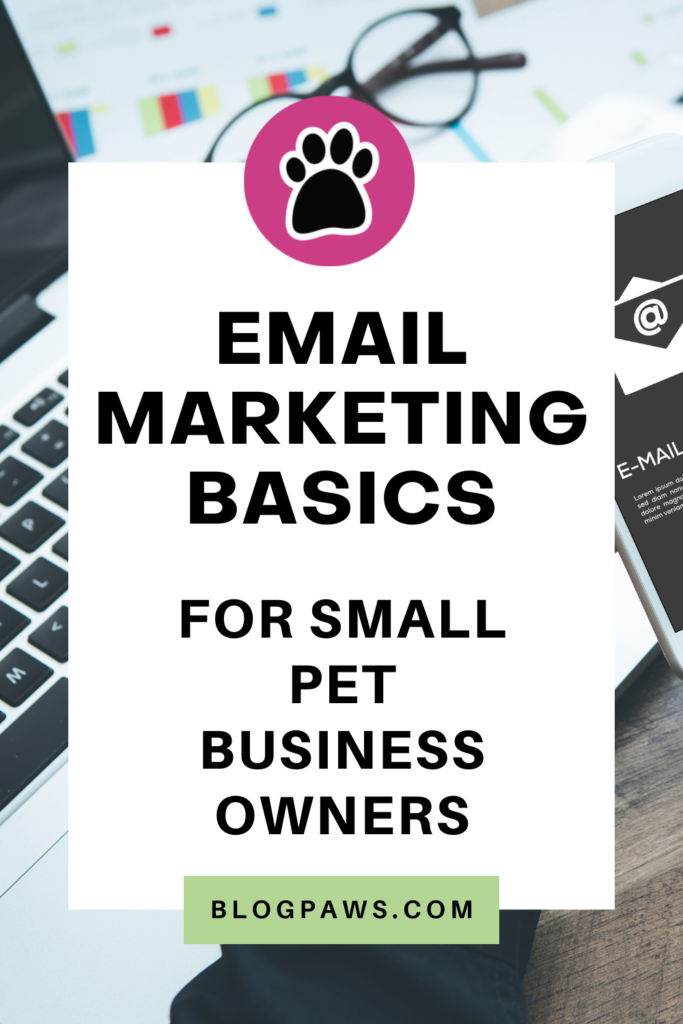Email Marketing Basics for Small Pet Business Owners
In a world where social platforms get so much attention, small pet business owners should not be overlooking the benefits of email marketing. When it comes to growing a community where you own the information (no shade to Meta… okay, maybe a little), understanding email marketing basics is imperative. There is no better way to engage and offer direct information than through using email marketing to reach people who choose to invite you to their inbox.
We know that even the basics of email marketing can sometimes feel like a lot to tackle, so we’re going to break down email marketing for beginners and go over the following:
- Why email marketing is relevant in 2023,
- How often you should email your list,
- What data you should track to help you with your email marketing goals,
- And, the main email marketing best practices to consider.
Email marketing has been an excellent tool for business growth for decades – yes, literally decades – and it’s not too late to start growing your list today.
Is Email Marketing Still Relevant in 2023?
Email marketing evolved from the first B2C emails that Hotmail (then HoTMaiL) helped create by being the first free web-based email platform for regular people in July 1996. Marketers had never been able to reach consumers without a phone call or a snail approach prior to Hotmail. What started as a spray-and-pray approach to email marketing quickly evolved into regulations and laws to help protect consumers from the marketers vying for a spot in their inboxes.
Today, with much more robust email marketing platforms that help with automation, personalization, segmentation, and even sales, email marketing is a key tactic to help any business fulfill their strategy and goals.
Imagine if a new visitor to your site sees something they really like – maybe it’s a DIY post or a How-To post or a product or a course – and they think, “I want to know more from this person.” If they have no way to take any kind of action that allows them to stay in the loop without clicking away to Instagram or Facebook, you might lose their eyeballs to someone who does.
But, if you have an opt-in on your site that connects them to a welcome sequence where you can introduce yourself more and share more about what they can expect from you in an automated fashion, then you not only captured their attention, you may have a new reader/customer for life.
That is the power of email marketing: create the systems, and you can engage with your people quickly and automatically.
How Often Should I Email My List?
One of the most common questions we get is, “How often should I be sending emails?” There is not a singular answer that fits all small pet businesses. It comes down to your goals and your capacity.
Instead of wondering how often you should send emails to your list, consider your goals, and create a plan to get there.
If you can do a weekly email, great. Make sure it’s filled with value.
If you can do more than once a week, great. Make sure you are offering value.
If you can only do it once per month, great. Make sure you are providing value.
Noticing a theme?
Your top question should be, “how can I provide value to my list, so they look forward to my emails?”
Set the expectations for what your list will receive in your welcome sequence, and then stick to those expectations. People like understanding what to expect.
For example, in our welcome sequence, we say this at the beginning of our first email:
We share educational content, events, and happenings we are up to, and we always work to keep it relevant and interesting. We will bring you free offers, paid offers, and any new courses/webinars we do.
Our expertise covers most things small online businesses deal with like digital marketing, content marketing, email marketing, social media marketing, business operations, web development, and public speaking.
Notice how we talk about sharing free and paid offers. If your emails are tied to sales goals, be sure to tell your audience that you will sell things in them. It can be as easy as saying, “We always share relevant offers, both free and paid, that can help you XXX.” XXX should be what you offer/sell.
In the end, find the balance of content, offers, and timing that works for you and create an email marketing process you can stick to. If you have a team working with you, create an email marketing guide that outlines all these decisions for consistency.
What Data Should I Be Tracking Throughout the Email Marketing Process?
While the exact data you need to track for your business may vary, there are some basic email marketing data points that everyone should know:
Open Rates
This is the percentage of people who are opening your email. If you have 1000 people on your list and 300 open your email, your open rate is 30%.
Keep in mind that with the last IOS privacy update, you will not always have fully accurate information, but this is still a baseline number that is relevant and important.
Average open rates vary by industry – meaning if you sell pet products, your average is probably different than someone who only shares content. However, a good place to be is over 30%. A great place to be is over 40%. An amazing place to be is over 50%!
Click-Through Rates (CTRs)
There are two types of CTRs:
- The basic Click Through Rate is the number of emails clicked divided by the number of emails delivered (see Bounce Rate). This number is usually much lower than people expect it to be. Very few industries exceed 2%, and many fall below 1%. A good place to start is in the 1% range.
- The Click To Open Rate (CTOR) is the number of unique clicks over the number of unique opens. This number is a better one to use when you want to know if the email content is doing its job because it will only show people who have already opened the email and whether they clicked.
To break it down, let’s say you have 1000 subscribers, 300 opened your email, and 20 clicked it after opening. This gives you:
- Open Rate: 30% (300 / 1000)
- CTR: 2% (20 / 1000)
- CTOR: 6.7% (20 / 300)
Unsubscribes
The number of people who choose to unsubscribe from your email list. This can be looked at on an email-by-email basis, an automated sequence basis (like in your welcome sequence), and an overall list basis.
While no one enjoys seeing people unsubscribe, a goal of your Welcome Sequence should be to get the people who realize they aren’t actually your people to unsubscribe. It’s better to have them exit quickly than hang around and throw off your ongoing stats. Hasta la vista, Baby!
Replies
This is not something your email software will track for you, but it is something to be aware of and something to ask for. Replies help validate your emails. They prove to all the email platforms that you send legit emails because people reply to them. So, take note when you get replies, and ask for them in your emails.
Bounce Rate
This is the number of emails that were not delivered. It happens for many different reasons. There are soft bounces and hard bounces.
A soft bounce means something between your send and your subscribers’ receipt made the system go haywire, and the email didn’t land in the inbox as planned. Most email platforms will try again, but only for a limited amount of times before they change a soft bounce to a hard bounce.
A hard bounce means the email is fully undeliverable. There are still many reasons for hard bounces to happen, but it is often because of an email address error. Once a subscriber hard bounces, they can’t get emails anymore. This can affect deliverability and the CTRs mentioned above. For instance, if you send 1000 emails and four hard bounce, your actual emails delivered is 996, which changes all the formulas above.
Email Marketing Best Practices You Should Know
The most important email marketing basics to consider involve understanding your audience. Can you put them all in one bucket because you offer very niche content/services/products? Or are you more like BlogPaws, with several different types of readers? The more diverse your audience, the more important personalization and segmentation are.
Regardless of how you personalize your emails, having a good welcome sequence, ensuring your emails are mobile-friendly, and using dynamic content to help with the personalization piece are all email marketing basics you should know.
Personalization
This can be as simple as inserting the code to put a person’s first name in an email. Instead of “Hi.” You can say, “Hi, Britt.”
You can take it up a level by using a custom part of your subscriber’s profile in an email. Let’s say you sell leashes. Instead of saying, “I hope you love your leash!” You could collect the exact type of leash purchased and say, “I hope you love your {SPECIFIC TYPE OF LEASH} leash!”
Segmentation
Segmentation differs slightly from personalization because it is more for internal purposes. It’s the way you want to group your subscribers. You may use the information to personalize their emails, but segmentation allows you to create different buckets of subscribers so you can track them as a group.
For instance, if we wanted to track those who create content but do not sell any products separately from those who also sell products, we could segment them into two different groups. At the same time, we could also segment out those who focus solely on cats, those who focus solely on dogs, and those who focus on both. That creates three groups of people who will be a different mix than the grouping based on whether they sell products.
Dynamic Content
Dynamic content in your email is shown based on your subscriber’s preferences. It’s another way to personalize your emails.
For example, we often add dynamic content in our emails for our PetBiz Collaborative members only. It’s something specific for them, and only appears in the emails tagged “PBC Active.” So, if you are a member, you see the message. If not, the email flows normally without the special content.
Dynamic content is a great way to address some of your subscribers personally without having to send a whole separate email.
Mobile Friendly
Nearly 42% of people use a mobile device to check email, and nearly 62% of emails are read on a mobile device. That means more than just making sure your images load mobile-friendly and your font is a legible size.
It also means looking at your content. Long paragraphs are overwhelming on a mobile device. Consider breaking it down and using bullet points, emojis, and headlines, so your email feels readable.
Your Welcome Sequence
A crucial part of your email plan needs to be your welcome sequence. We recommend delivery over a short time frame, no more than a week after a subscriber first opts in. Your welcome sequence should do the following:
- Deliver whatever freebie they are expecting immediately, if is one involved.
- Have a clear brand tone – are you funny, witty, smart, or educational – whatever tone you usually write your emails with, be sure it comes across immediately.
- Introduce yourself and your team, if you have one.
- Set expectations of what your new subscriber can expect from you.
- Share one of those expectations with them as an example.
Depending on your business, this can be done over 3-5 emails. Once your subscribers move through your welcome sequence, you add them to your regular email flow. Don’t automatically put them in your email flow when they first sign up. Use the welcome sequence to make sure they are a fit for you. Remember, you want them to unsubscribe quickly if they aren’t a good fit.
Email marketing can be as easy or as complex as you want to make it. As long as you know your audience, you know how to provide them value, and you are looking at what is working and what isn’t, you are on the right track for email marketing growth.
Now that you understand the email marketing basics, what steps do you plan to take to boost your marketing efforts? We invite you to share your goals with us in the comments!
About the Author: Chloe DiVita, BlogPaws CEO, has 15+ years of experience in digital marketing, the pet industry, and as a greyhound mom. She’s earned accolades like, Pet Age’s 40 Under 40 and Muse Medallions from the Cat Writers’ Association. Formerly Executive Producer for TEDxCambridge, she brings storytelling and public speaking to her work with creators, leaders, and brands. Read more…





2 Comments